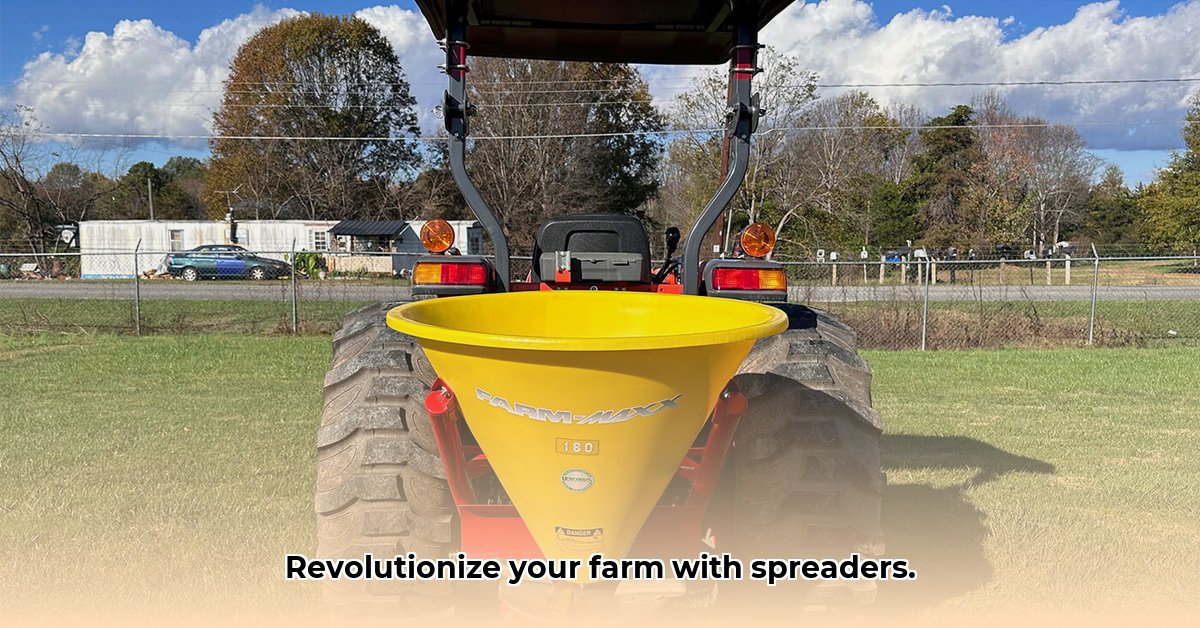
Optimizing Fertilizer Application for Sustainable Yields
Efficient fertilizer use is crucial for maximizing crop yields while minimizing environmental impact. Tractor spreaders, when properly used, offer a powerful tool for achieving both goals. This guide provides a practical, step-by-step approach to mastering the use of tractor spreaders to promote sustainable farming practices. Understanding the nuances of fertilizer application, calibration, and spreader maintenance is key to optimizing your farming operations. Are you ready to maximize your fertilizer investment and minimize environmental risk? For more information on tractor spreaders, check out this helpful resource: Tractor Spreaders.
Choosing the Right Spreader: Centrifugal vs. Spinner
Selecting the appropriate spreader type is the first step towards efficient fertilizer application. Two common types are centrifugal and spinner spreaders. Each excels in different situations:
| Feature | Centrifugal Spreader | Spinner Spreader |
|---|---|---|
| Best for | Granular fertilizers (e.g., bagged fertilizers) | Dry, granular materials; potentially more precise for smaller areas |
| Application Rate | Typically higher, good for large fields | Variable, often lower; adaptable to specific field needs |
| Accuracy | Moderate; improves significantly with calibration | High with careful calibration; beneficial for variable-rate application |
| Coverage Area | Generally larger | Smaller |
| Maintenance | Moderate | Moderate |
The choice depends on your farm's size, the type of fertilizer used, and the desired level of application precision. Larger operations often benefit from the higher capacity and broader coverage of centrifugal spreaders, while smaller farms or those requiring precise application may prefer spinner spreaders. How will you determine which spreader best suits your unique needs?
Calibration: The Cornerstone of Efficient Fertilizer Use
Inaccurate calibration is a significant source of fertilizer waste and environmental damage. Over-application leads to nutrient runoff, polluting waterways and reducing fertilizer effectiveness. Under-application, on the other hand, stunts crop growth and diminishes yields. Precise calibration ensures you apply the right amount of fertilizer, maximizing your investment and minimizing environmental impact. What's the secret to achieving perfect calibration?
Calibrating Your Tractor Spreader: A Step-by-Step Guide
Preparation: Choose a level, obstacle-free area. Gather your fertilizer, a scale, measuring cups, stopwatch, and a notepad. Safety gear (gloves and eye protection) is essential.
Loading and Setup: Fill the spreader according to the manufacturer's instructions, ensuring even distribution. Verify all components are correctly assembled and in good working order. Consult your spreader's manual for specific pre-calibration checks. A well-maintained spreader is crucial for accurate application!
Test Run: Spread fertilizer over a precisely measured area (e.g., a 50-foot by 10-foot rectangle). The exact dimensions will depend on your spreader's capacity and the desired application rate. Your owner's manual should provide guidance.
Measurement: Carefully collect the spread fertilizer. Weigh it accurately to determine the actual application rate. This step is where precision matters most.
Adjustment: Compare the measured application rate with your target rate. Adjust spreader settings (spinner speed, gate opening, etc.) as needed. Your spreader's manual will detail how these adjustments affect application rates.
Repetition: Repeat steps 3-5 until the spreader consistently delivers the desired amount of fertilizer. Achieving consistent results is critical for optimal resource management.
Fertilizer Types and Their Impact on Application
Different fertilizers have varying properties that influence spreader performance. Granular fertilizers, commonly used with centrifugal spreaders, offer a relatively consistent application pattern. Newer slow-release fertilizers, which minimize nutrient loss, often demand more precise calibration due to their gradual nutrient release. Choosing the right fertilizer depends on your soil type, crop requirements, and environmental goals. What considerations should guide your choice of fertilizer?
Environmental Responsibility: Sustainable Fertilizer Management
Sustainable farming requires responsible fertilizer use. Even with precise calibration, additional practices contribute to minimizing environmental impact:
- Avoid windy days: Wind can cause fertilizer drift, wasting product and polluting the surrounding environment.
- Maintain buffer zones: Establish adequate buffer zones around water bodies to prevent nutrient runoff and protect aquatic ecosystems.
- Regular maintenance: Consistent maintenance prolongs the spreader's lifespan, reduces the need for replacements (and associated resource consumption), and ensures accurate application over time.
- Fuel efficiency: Choosing fuel-efficient tractors reduces your farm's carbon footprint. Could you consider electric or hybrid tractors in the future?
Long-Term Sustainability: A Continuous Process
Sustainable farming is a long-term commitment. Regularly review and refine your fertilizer application techniques. Stay abreast of best practices and emerging technologies to optimize your farm's efficiency and environmental impact. How can you make your farm more sustainable over time?
Key Takeaways:
- Precise fertilizer application is paramount for maximizing yields and minimizing environmental impact.
- Proper calibration is crucial, requiring careful measurement and adjustment of spreader settings.
- Regular recalibration is necessary to account for varying conditions and fertilizer properties.
- Sustainable farming involves integrating responsible fertilizer management with broader environmental stewardship practices.
This guide provides a foundation for maximizing the benefits of tractor spreaders while minimizing environmental impact. By implementing these strategies, you can contribute to a more sustainable and productive agricultural future.